Carbon Emission Analysis Of The Vitamix FoodCycler
Wondering if the FoodCycler electric composter produces more carbon emissions than it offsets? After doing a comprehensive and unpaid review of the FoodCycler, I’m diving into the carbon emission tradeoffs of using the FoodCycler compared to landfilling or composting your food waste. Read on for data and conclusions based on governmental environmental sources to understand the relative carbon emission analysis of the Vitamix FoodCycler as a food waste management solution.
Looking for a better electric compost bin? I’ve tried several electric kitchen bins, and this one is my favorite! Check it out.
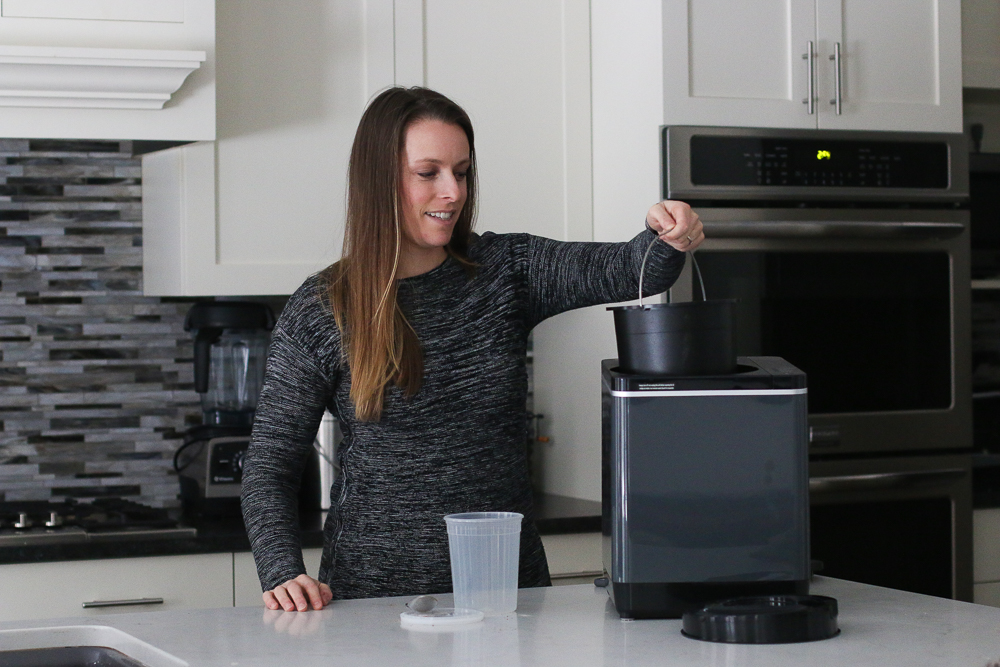
Update: I no longer use the FoodCycler. You can read more about my review of the Vitamix FoodCycler here as well as other resources and thoughts on electric compost bins as part of our food waste management future.
A few months ago I purchased a Vitamix FoodCycler FC-50 to experiment with it and find out if it was the magical solution to composting at home that some touted it to be. The FoodCycler electric composter is a small kitchen appliance that breaks down food waste in a matter of hours without any smells or hard labor. I wrote a comprehensive review of the FoodCycler.
Within minutes of plugging the FoodCycler into my wall, however, I began to wonder about the true carbon emissions (CO2e) benefits of using energy to break down food waste instead of sending food waste to a landfill where it emits methane (a potent greenhouse gas) during anaerobic decomposition. This was also one of the most common questions I received from others about the FoodCycler.
Carbon Emission Analysis Of The Vitamix FoodCycler
I set out to do some research and corresponded with a representative from FoodCycler as well to gather data, crunch some numbers, and think holistically about the CO2e costs and benefits of the FoodCycler.
How Much CO2 Emissions Come From Food Waste?
Before diving into CO2e from the FoodCycler, let’s start by understanding the scope of emissions from food waste globally. I’ve seen figures estimate CO2e from food waste between 1.3 kg – 2.5 kg of CO2e per kilogram of food waste. For the analysis I completed below, I used the 1.3 kg CO2e to be conservative.
The higher estimate came from research conducted by the Food & Agriculture Organization of the United Nations (FAO) that stated we waste 1.3 gigatons of edible food each year. This food waste releases 3.3 gigatons of CO2 equivalent (without taking into account land-use change). That means that 1 kg of food waste contributes 2.5 kg of CO2 equivalent to our atmosphere. For perspective, if food waste were a country, it would be the third-highest emitter of greenhouse gas emissions each year behind China and the United States. That’s pretty crazy!
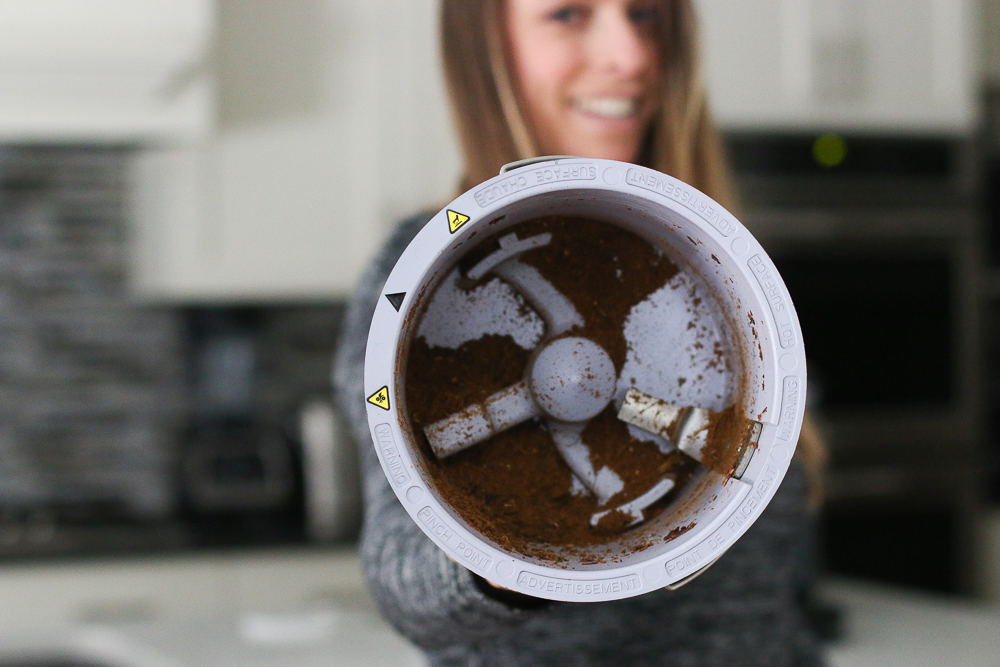
How Much Energy Does The FoodCycler Use?
According to the Vitamix FoodCycler FC-50 manual, the FoodCycler uses about 0.8 kWh (kilowatt-hours) of energy per processing cycle. To put this in perspective, the United States Energy Information Administration says an American uses an average of 877 kWh per month. Thus, if an average American uses the FoodCycler once per week, it represents about 0.36% of home energy usage. Using it every other day or every day, the FoodCycler would represent 1.37% or 2.74% of monthly energy use, respectively.
How Much Carbon Dioxide Emissions Result From FoodCycler Use?
The CO2e (or carbon equivalent emissions) from the use of the FoodCycler depends significantly on the type of energy used in your home. If your electricity comes from a power plant that uses coal, the FoodCycler will have a much larger CO2e rate than if your home is powered by renewable energy resources like solar, hydro, or wind power. The FoodCycler processes about 1 kilogram (kg) of food waste and uses about 0.8 kWh of energy per cycle. Let’s compare a few different energy source alternatives.
100% Coal-Powered Energy Source
Coal emits about 2.2 pounds or 1 kg of CO2e per kWh of energy it produces and has the highest rate of CO2e relative to other types of energy sources, according to the United States Energy Information Administration (and coal’s dirty reputation). In a comparison of different energy sources, using coal to power the FoodCycler is the worst-case scenario.
Energy Source Based On Average Energy Mix For United States Consumer
In the United States, when we consider all fuel sources, the average CO2e from all energy sources is 0.40 kg per kWh. This is a 60% reduction in CO2e relative to coal. Carbon emissions of 0.4 kg/kWh (or 884.23 lbs/MWh) are based on data published by the United States Environmental Protection Agency showing total CO2 output emission rates in 2019 for the United States overall and by eGRID subregion. Using the average energy mix to analyze carbon emissions from FoodCycler use is a mid-case scenario that best represents our current circumstances.
100% Renewable or Zero-Carbon Energy Source
If the FoodCycler is powered exclusively by renewable energy resources like wind, hydro, or solar power or a zero-carbon energy source like nuclear energy, we’ve achieved a best-case scenario concerning carbon emissions as none of these energy sources produce CO2e.
Waste Hauling Emissions
Regardless of energy source, we also should consider the emissions from waste-hauling vehicles required to transport food waste from our homes to landfills or incinerators. While the actual emissions from these vehicles are hard to measure per unit of food waste, it’s worth noting that food waste is quite heavy.
The use of the FoodCycler eliminates waste-hauling emissions if the Foodilizer is used at home. If the Foodilizer is thrown out, it still offers an 80-90% reduction in waste hauling volume and a significant decrease in the weight of the waste due to the drying and processing that occurs in the FoodCycler.
Net Carbon Emissions From The FoodCycler By Energy Source
As shown in the chart below, even in the worst-case scenario using the FoodCycler powered 100% by coal, we still achieve a net reduction in CO2e of 0.5 kg per FoodCycler processing cycle, after considering energy usage by the FoodCycler relative to reduced landfill emissions from food waste that doesn’t end up in the landfill. This net reduction does not include waste hauling transportation emissions, which is an additional relative benefit of the FoodCycler.
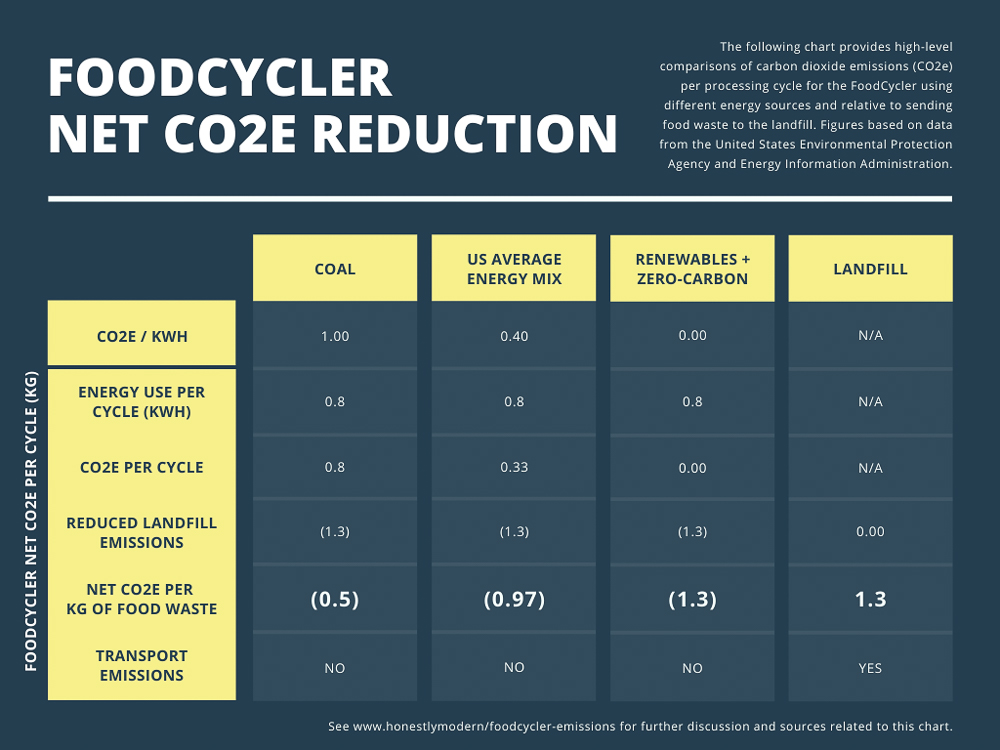
As our energy sources continue to move toward more zero-carbon and renewable sources, the FoodCycler will capitalize on this shift in our energy resource mix and move closer to the renewable and zero-carbon best-case scenario estimated above.
Backyard Composting vs. Electric Composter
In the context of discussing carbon emissions from the FoodCycler and electric composters in general, it’s worth noting that backyard composting also releases some CO2e. Below (with the help of my friend Jess from Thoughtfully Sustainable), I created this diagram to show the very basic chemistry of sending food waste to the landfill instead of the compost bin.
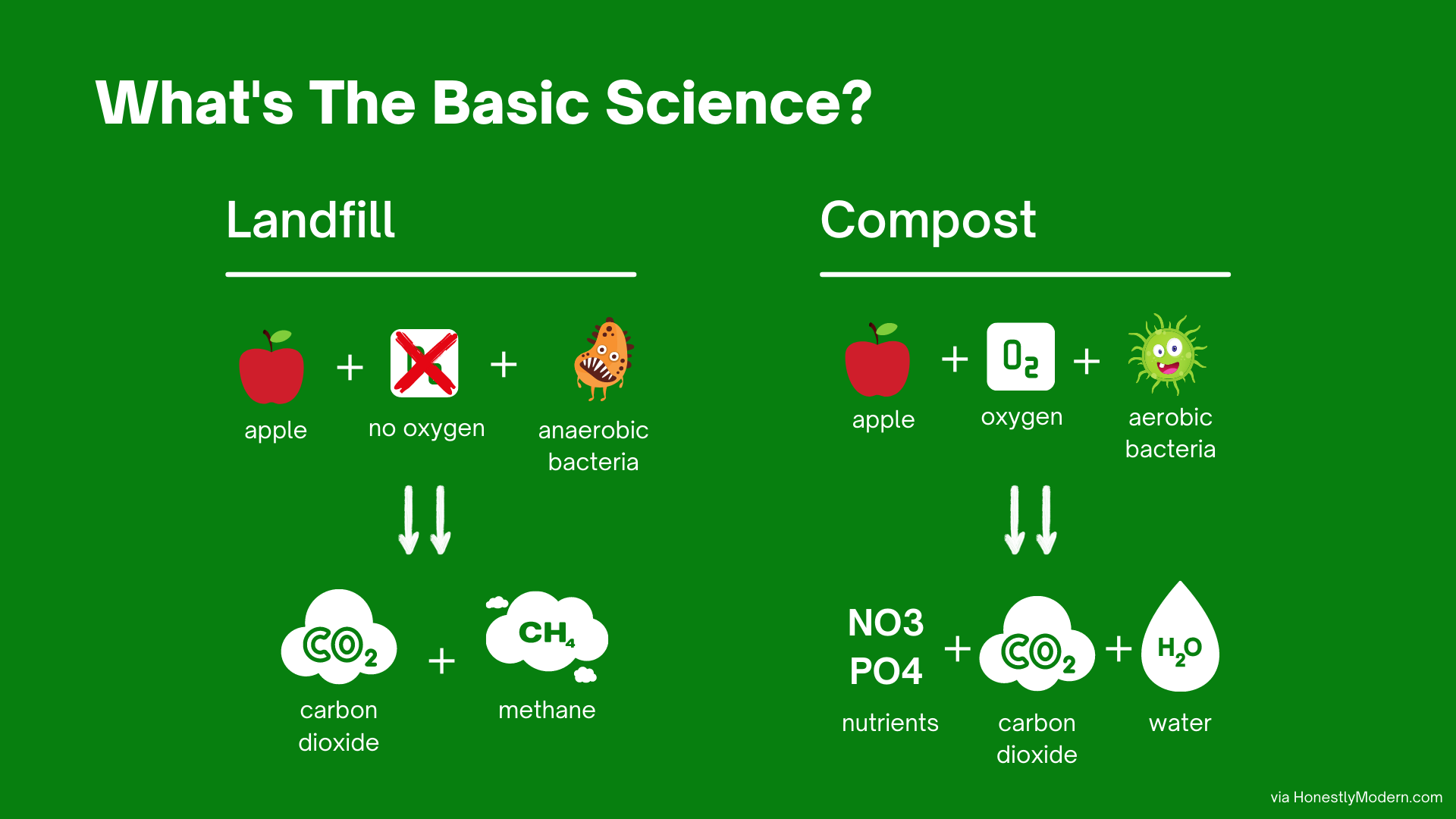
Although landfill waste produces much more greenhouse gas emissions than backyard composting, a typical compost bin produces nutrients for the soil, water, and a bit of carbon dioxide. Composting is a rapid version of nature’s recycling system, so this carbon dioxide output is a product of the same process that happens when dried leaves fall to the forest floor and decompose over time to replenish the soil. In other words, it’s natural and it’s not a concern in our rush to reduce greenhouse gas emissions.
I mention it though for relative considerations and to add another angle of perspective about the minimal CO2e from FoodCycler processing cycles. According to FoodCycler, backyard composting produces more CO2 emissions per kilogram of food waste than the FoodCycler in certain circumstances.
FoodCycler’s metric is based on the energy resource mix of Ontario, Canada, where 96% of electricity is generated using zero-carbon emitting sources, according to the Canada Energy Regulator Provincial and Territorial Energy Profile for Ontario. Ontario’s electricity comes 60% from nuclear, 26% from hydroelectricity, 7% from wind, and 2% from solar. The remainder is primarily from natural gas, with some biomass.
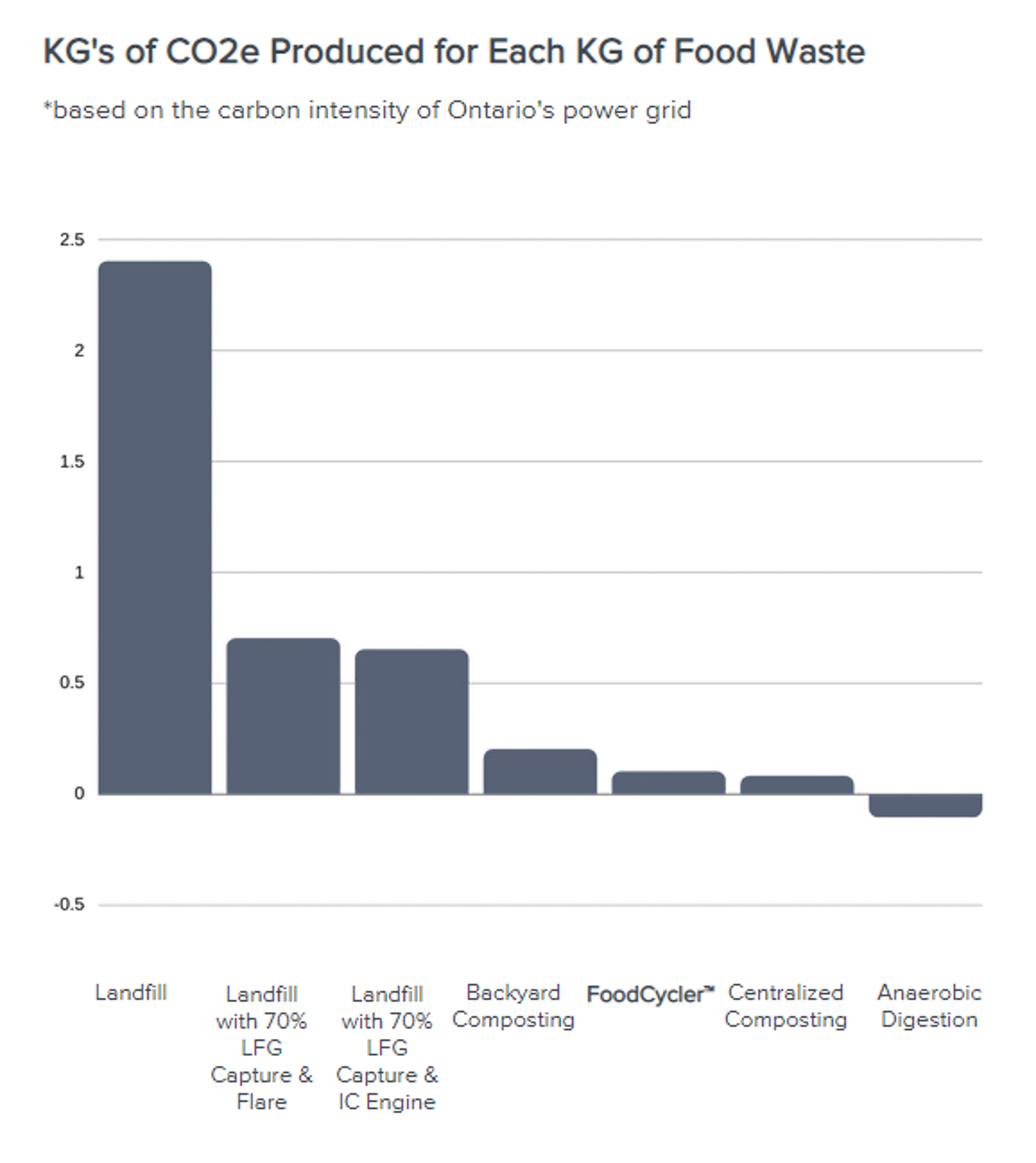
In the United States, according to the Resource Mix data from the Environmental Protection Agency, the amount of zero-carbon energy sources varies widely based on geographic location. The chart below shows the energy mix for each eGRID subregion in the United States, and some regions are heavily reliant on fossil fuels. Thus, backyard composting might release fewer CO2e than the FoodCycler if you live in an area powered primarily by fossil fuels.
This interactive chart from the EPA is pretty neat (at least to me), and you can see that regions like upstate New York (NYUP) use almost 75% zero-carbon energy sources (thanks mostly to nuclear energy and hydropower). The New York City region (NYCW), meanwhile, uses only 41% zero-carbon energy sources while New York’s Long Island area (NYLI) relies heavily on fossil fuels and includes only 12% zero-carbon energy sources in their resource mix. Where you live really matters, even if you’re in the same state!
The Right Composting Method For You Is About More Than Carbon Emissions
There are many other eco-friendly considerations to weigh beyond CO2e when comparing various composting methods to the use of the FoodCycler. Depending on the method of backyard composting you use, for example, there may be fewer upstream manufacturing impacts of backyard composting relative to the production and transportation of the FoodCycler to your home. Backyard composting provides a breeding ground for biodiversity and allows for a higher volume capacity of yard waste or larger items that don’t fit in the FoodCycler.
Alternatively, backyard composting can release methane (like in the landfill) if the pile isn’t managed properly, and it isn’t suitable for foods like meat and dairy that can go in the FoodCycler. Furthermore, backyard composting just isn’t an option for many people given time, resources, space, and physical ability limitations.
I’d like to see more compost pick-up services. I think these are best aligned with our current lifestyle habits, offer the most accessibility and equitability when driven by municipal priorities, and can keep the benefits of the food waste system local. It’s not a perfect solution, but I think it’s one of the best options right now that could provide the biggest impact.
This set of comparisons isn’t exhaustive but is evidence of the complex circumstances that warrant a multitude of food waste management options so each person or family can use the options that work best for them. If you think the FoodCycler might be a good composting solution for you, check out the full FoodCycler review.
I’ve also shared 13 ways you can compost at home. Head on over to check more details including the pros, cons, and price considerations of more than a dozen ways to compost at home.
If you have questions, let me know in the comments and I’ll do my best to answer them.

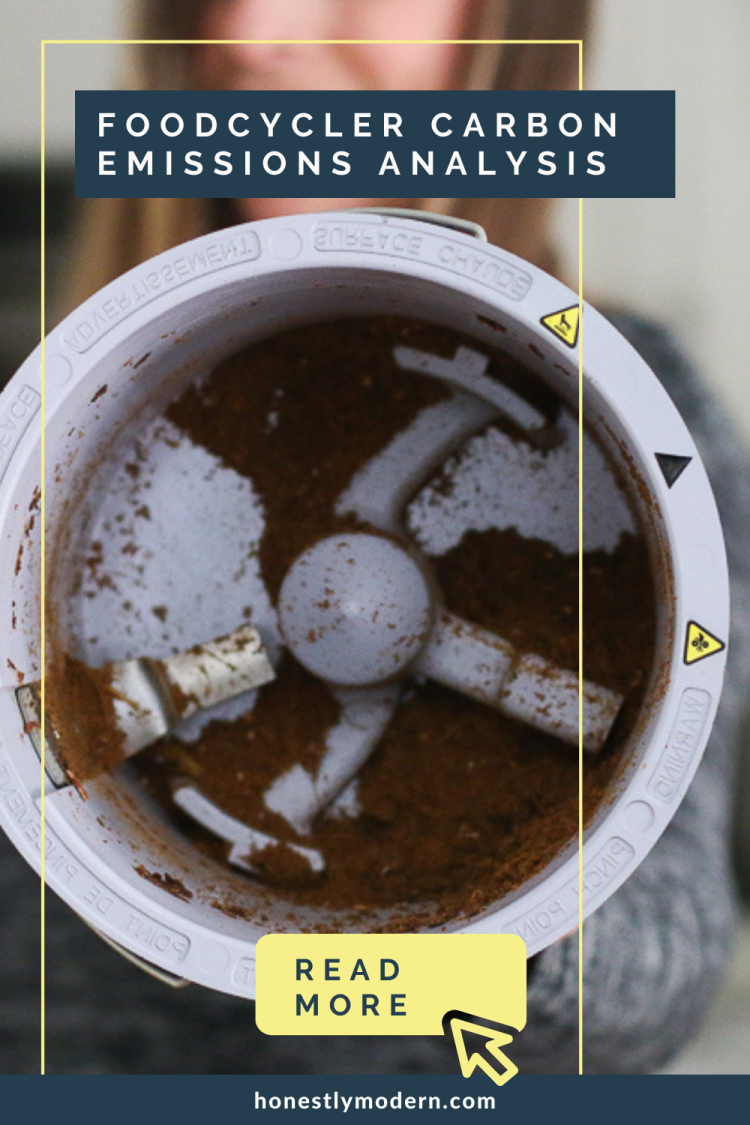
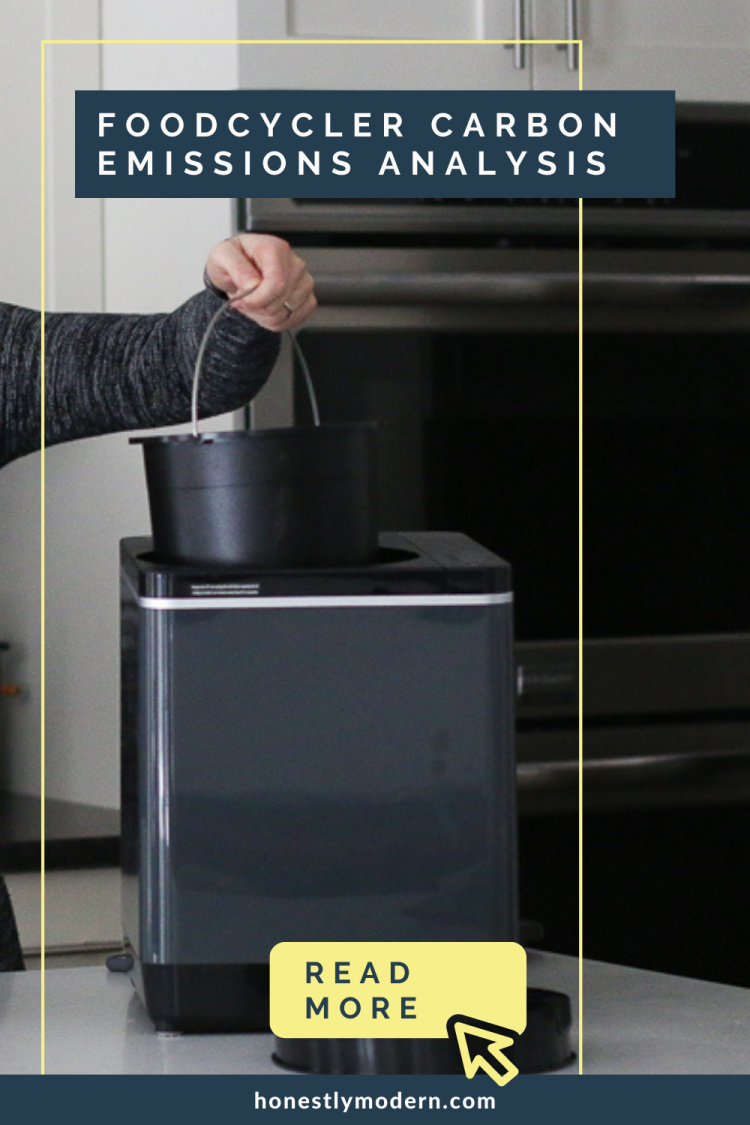
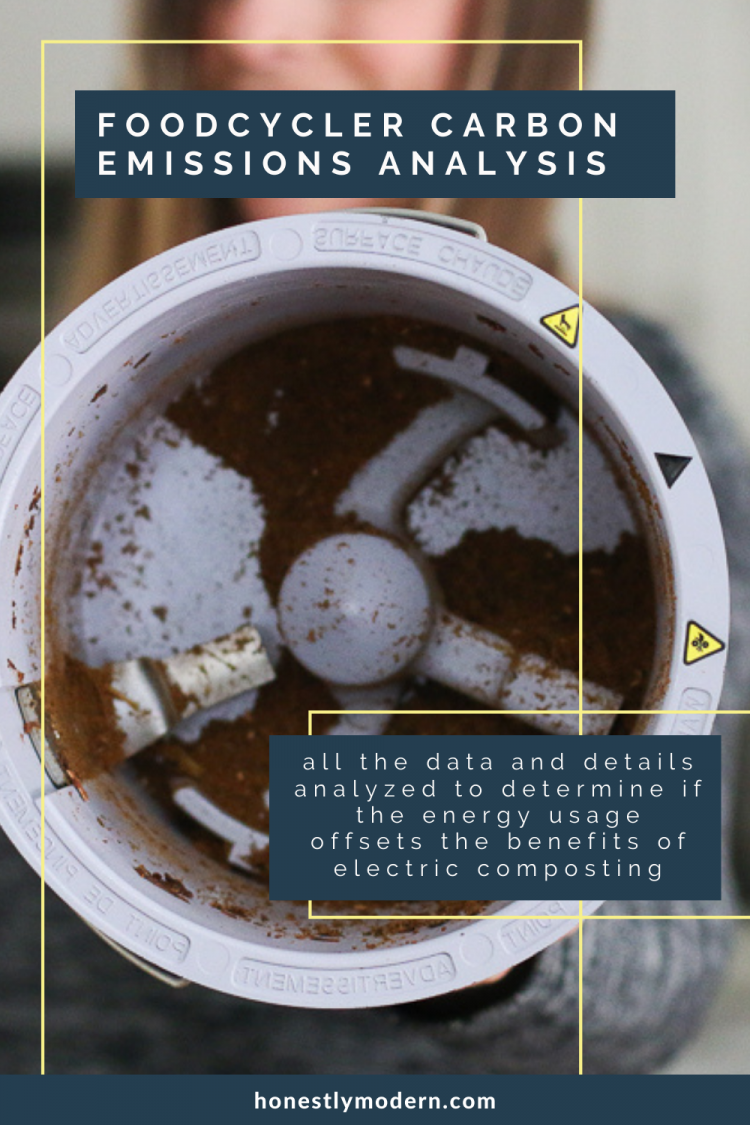

Jen Panaro
Jen Panaro, founder and editor-in-chief of Honestly Modern, is a self-proclaimed composting nerd and advocate for sustainable living for modern families. To find her latest work, subscribe to her newsletter, Stepping Stones.
In her spare time, she’s a serial library book borrower, a messy gardener, and a mom of two boys who spends a lot of time in hockey rinks and on baseball fields.
You can find more of her work at Raising Global Kidizens, an online space to help parents and caregivers raise the next generation of responsible global citizens.

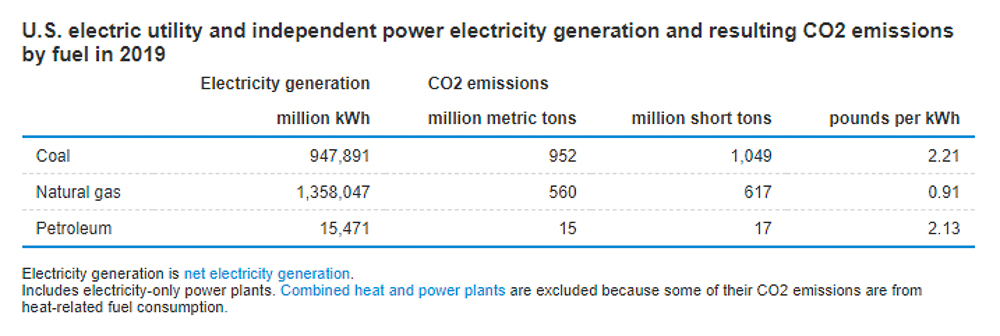
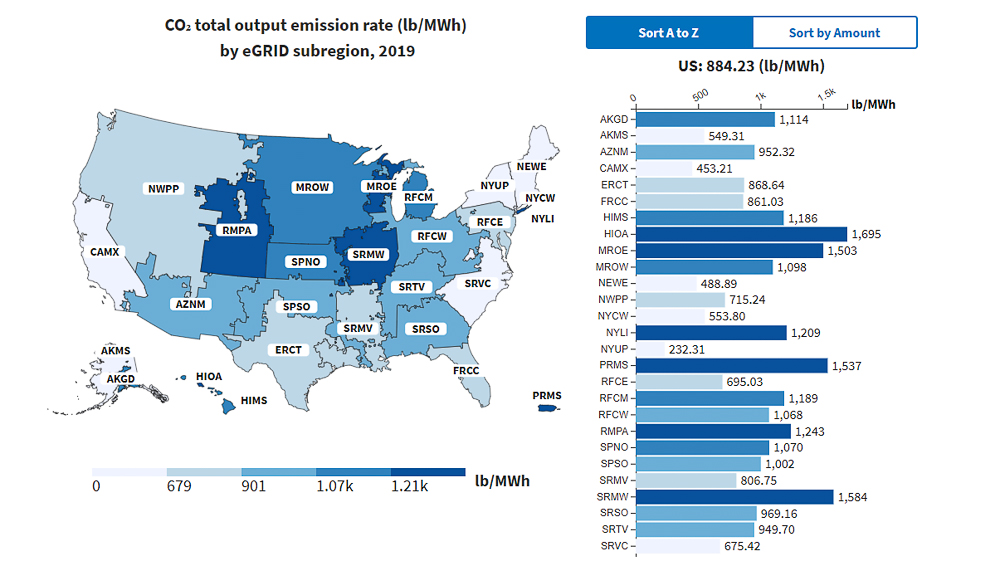
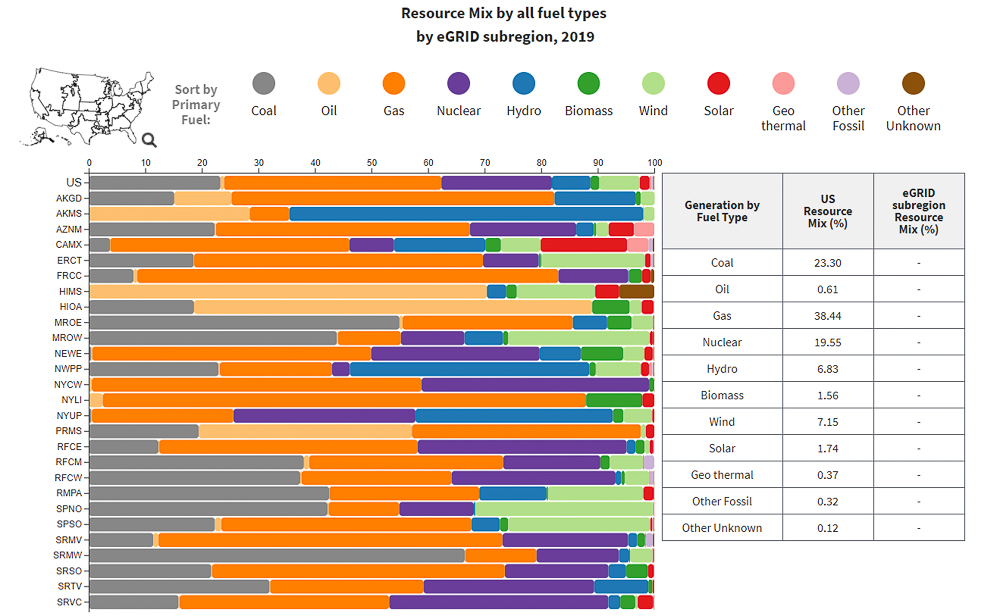

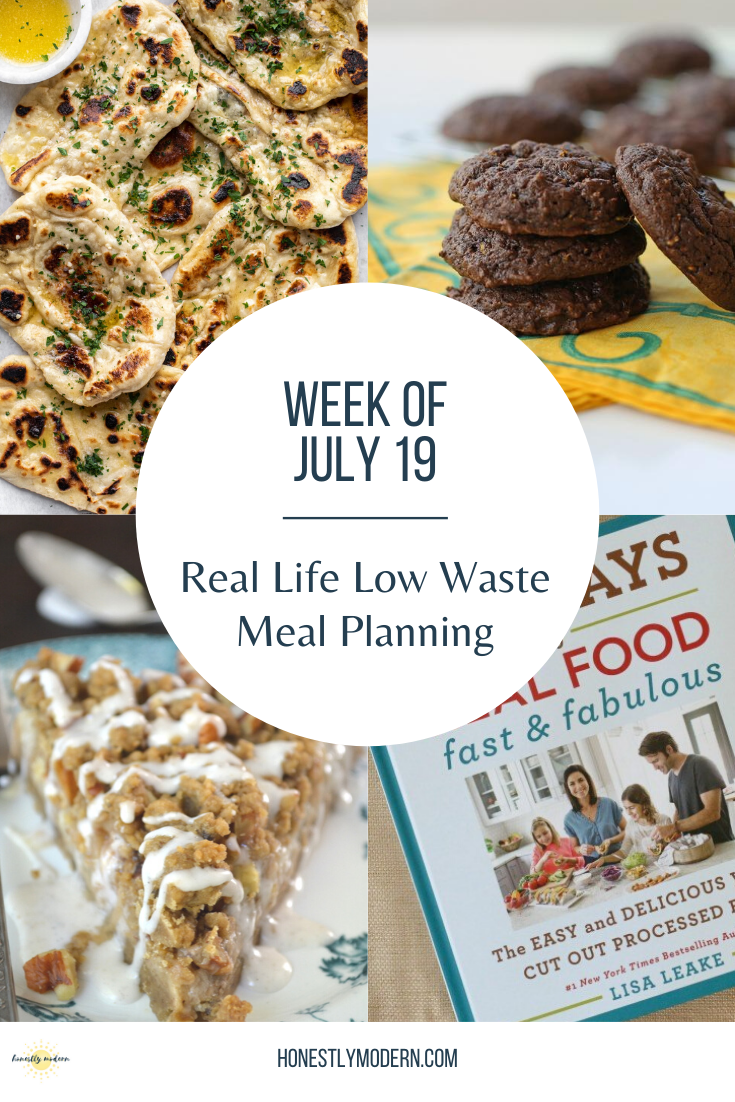





Love! Thank you!
The estimate of wasted food includes “expired” but not yet truly spoiled food. A more effective measure than composting would be to realize that we have an immune system and a few bacteria or mold spores are not a barrier for consuming that food. Most slightly gone food can be used in cooking where it is sterilized and largely loses its original texture anyway.
I don’t think the average person produces copious volumes of vegetable peels. We mostly eat cleaned, processed food, seeds instead of potatoes or frozen veg.
You’re correct that a lot of the wasted food could and should be eaten and doesn’t need to be composted. I don’t think, however, that that takes away from the viability of a tool like the FoodCycler being part of the efforts to collectively reduce food waste. Eating more food is definitely one important “tool”, however, in our arsenal of ways to help limit the food that gets wasted.
Hi! We were wondering shout the CO2e for manufacturing the foodcycler and how that affects the carbon footprint equation. Thank you for your analysis.
Hi Shirley – That’s a great question and one I, unfortunately, can’t answer. I don’t have access to the manufacturing and upstream process of the FoodCycler. It’s definitely something to consider though when weighing our options for reducing food waste. Thanks for the note.
Usually, large scale operation are more efficient that a multitude of small scale ones… In California, there are now requirements to divert food scraps from landfill to compost production. They are already trucking the trash and recycle, so the cost of trucking the food scraps to a facility seems like a negligible. Might still buy the machine because it’s a cool gadget…
Thanks for your thoughts. It probably depends on how they are trucking and to where, etc… If it’s the same number of trucks, then it’s probably negilble. If it’s more trucks to carry to different waste streams, that might not be the case. So many nuances and complexities. 🙂
This entire post is brilliant and so appreciated. It’s exactly what I was wondering about the FoodCycler, and thank you for doing all this research.
I had the same question as Shirley, but I also think the same question applies to non-electric composting units (which are bulky + made of rubber/metal/etc + shipped all the way from Asia) that those of us in the city have to buy for our yards… So the “how much is emitted by manufacturing” question seems to apply to both electric + non-electric units, and therefore might be moot.
(As an aside, my mom lives in a suburban-to-rural part of States and where she just piles compost in a heap and it works fine. No bin of any kind involved. So if you want to skip using anything manufactured, you can)
That’s a really good point about all the different systems going through some type of manufacturing process. 🙂 Also, I agree that if you have space, you don’t need anything at all. We even made a wooden compost bin out of some old pallets and chicken wire we already had, so that’s another option. Thanks for the tips! https://www.honestlymodern.com/wooden-pallet-compost-bin-tutorial/
My understanding is that the product that comes out of this machine is basically chopped up, dehydrated food scraps. If those food scraps are composed in the back yard before being put in the machine, they will release some CO2 in the composting process, while also locking up some carbon in the humus in the compost.
But don’t the dehydrated food scraps release the same amount of carbon when added to the soil, where they are also broken down by microbes, just like compost is? It’s just that using the machine also adds in electricity + manufacturing resources to the process and backyard composting doesn’t. It seems like the numbers here may not account for the CO2 release from the dehydrated food scraps once after they are put in the soil.
Hi Ben – you are correct that I didn’t account for the CO2e from food scraps/Foodilizer once in the soil. But as you mentioned, I don’t think that is materially different than just throwing food scraps into a compost pile. It’s essentially a wash. From my perspective (and I’m not a climate scientist or a professional scientist), I consider the natural carbon cycles of things that grow and die in a short period of time part of a sustainable and regenerative existence. I think our real issue comes from the carbon emissions related to fossil fuels that took millions of years to be “stored” and are now being released at “crazy rates” (my very fancy term for the relative use of carbon now vs its storage over time in the past – haha). Thanks for the note.
Ben, this is correct . The foodcycler dries the material, which is going to release the same amount of carbon when it is ultimately rehydrated – combusted or metabolized. The foodcycler process does not reduce the carbon-hydrogen bonds present in the food, it just evaporates the water. This comparison is therefore incorrect by a large margin if the GHG released by the finished product from the foodcycler is not included, but compared to other options where it is included.
Hello Jen:
Came here after being bombarded by ads for the Lomi composter (a different product from the Vitamix food cycler, but similar in usage intent, and presumably target customers). One question I have about these products that I cannot find the answer to anywhere I’ve looked: what are their gas emissions during use in the home? I am not talking about overall carbon footprint or GHG neutrality, but rather what gases do they emit into your kitchen, etc.? Is there methane released during the cycle?
Hey Keith – That’s a good question but I am not sure of the answer. I wonder if their customer service could answer that.
Awesome blog post. I have the same question as Keith. I think we woud need at gases analyzer to figure this one out. This is a very cool question to look into! I’m wondering if Jen or Keith are interested in partnering on this project? I might be able to help!
Thanks for the interest. I don’t have the capacity to be a good teammate on this right now, but good luck with the experiment/research if you look into it. And let me know how it goes because I’d love to check out the finding and link to them from this post. Thanks!
Thanks for your reply! Surely an interesting case. I’ll mention it to my lab and see if we have any takers 🙂
This article completely glosses over the REAL killer for why these “rapid composters” don’t work:
By heating up your food waste to desiccate it, you’re destroying all the nutrients that would make it compostable. You’re basically sterilising it.
Also, if you want to be more environmentally friendly, use less energy. IT DOESN’T MATTER WHERE YOUR ENERGY COMES FROM.
Here’s an excellent video from a research scientist on YouTube debunking a very similar product, Lomi. And in this video, he mentions the Foodcycler:
Hey Duncan. Thanks for sharing this. Your perspective is something I’ve been working through myself for quite some time in terms of “where is the market need really?” for these products (if there is one?). I know there are varying perspectives on this matter and appreciate you sharing yours. I entirely agree that (at the very least) it’s definitely very low on the list of “best practice” composting options.
This is super helpful! I am considering buying an electric composter and it is great to see someone doing such a detailed analysis.
I would be curious to know if you also considered the following:
1) CO2e emissions generated in the process of manufacturing the device (e.g., emissions released for producing the steel and plastic used to make it, etc.)
2) shipping process of receiving the composter
3) Any emissions associated with the disposal of the machine
4) Any refills, replacements, etc. required
I do not suspect these will be large compared to the electricity consumption but curious about these other factors.
I haven’t done that analysis, so I’m not sure but it’s a great question. To be honest, since writing this article, I’ve become more skeptical about the true benefits of these machines. I have been working on writing more through reviews and haven’t finished yet. But I wonder how much this machine makes sense for a lot of people. Primarily, the people who would often use it (especially those living in small spaces/apartments/etc…) also don’t often have a use for the output. And when that’s the case, what’s the point? So while I definitely want to encourage composting in a variety of ways, I’d suggest thinking about whether or not you have a true use for the output. If you do, that’s great. But if not, maybe it’s not the best option (and you can save your money). 🙂